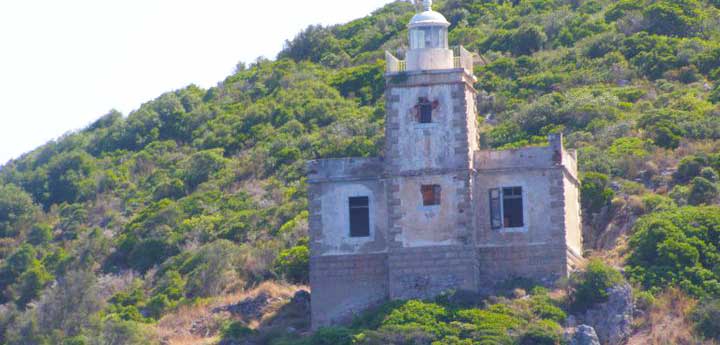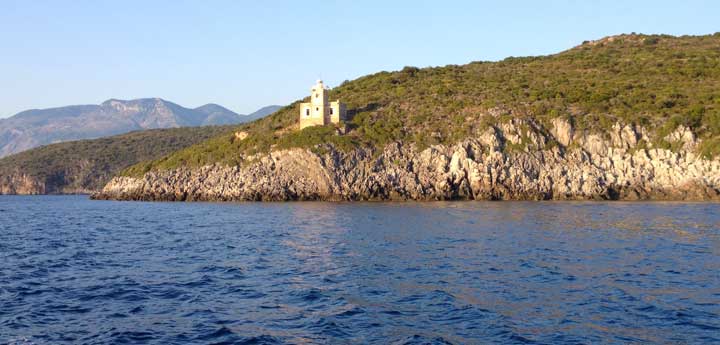Destinations
the lighthouses of messinia
The Lighthouses of Messinia
The tireless and vigilant guardians of our seas!
Messinia Sailing makes daily voyage to our lighthouses, the tireless and vigilant eyes and the least we can do as a tribute to them is to tell you their history, for you to fall in love with them, to enjoy their brilliant light , to listen to what stories they have to tell you on one of our romantic cruises. Stories of storms, smashed ships, wrecks, wars, and guidance of thousands of ships that have seen their eyes during their age old vigilant presence in our seas.
Stories of mermaids, dolphins, romantic stories during circumnavigating of famous Heart Island by holding the hand of your beloved and renewing your promises of love.
The old image of the lighthouse keeper on the tower to salute by waving his hand, give us courage, strength and safety on our travels.
This picture is deep in the mind of our seamen. Their memory is eternal!
Lighthouse of Cape Kitries (E4032 - GR 2260 - Lat.36 54.88N Long.022 07.60E)
Located 6 n.m. south of Kalamata on the edge of the Cape Kitries or Kefalovouni.
Nestled in the bosom of the rocks at a height of 20 meters from the sea. The lighthouse’s main building dimensions are 7.00 x 11.5 m and it has a total area of 80 sq.m.
The square tower with a height of 9.50 m has an internal staircase with marble stairs leading to the top metal tower. Its elevation is 31 m and has a lightning rod on top
It was built by the contractor Athanasios Marinos and delivered to the Ministry of Navy at the end of October 1891. It first operated on 01.06.1892 as a warded lighthouse. It had a clock mechanism with rotating counterweights and its energy source was oil. Its characteristics were Fl W 30s 10M.
During the Second World War the lighthouse was extinguished. The German occupation forces, shortly before leaving Kalamata in 06.09.1944, bombarded the lighthouse from the shore gunneries but did not destroy it. On the night of 05th February 1949 during the civil war, its beacon was destroyed by two gunmen and the lighthouse was turned off temporarily. In 1950 it was equipped with an English automatic acetylene torch. Since then the lighthouse was converted into unattended with characteristics Fl (2) W 12s 12M. In 1999 it was equipped with a solar system and characteristics Fl (2) W 12s 7M.
Mr. George Lagoudakos (the last lighthouse keeper) withdrew in 1953, following the lighthouse automation. Today lighthouse building lays unprotected and requires maintenance work.
Lighthouse of Sapientza Island (E4015 GR 2170 Lat.36 47.73N Long.021 42.22E)
Sapientza in the Inouses group of islands is on an important shipping route, connecting the West Mediterranean and Italy with the Middle East. It is the first lighthouse you meet when approaching Greek waters from the west. On surrounding coasts they are several wrecks some of which were carrying very important and valuable cargo for archaeologists today. One of the wrecks contained the columns from the large peristyle which was built by Heroid in Caesarea of Palestine in the 1st AD century, while another contained a significant Roman sarcophagus. That was why the construction of a lighthouse at this point was so important.
South of Sapientza, at a short distance are the islets of Two Brothers. On the most western islet there are ruins of an age old lighthouse that was built by the British.
The newest lighthouse was constructed at the request of Queen Victoria of England in 1885 It is located on the SE cape of Sapientza island. The height of the stone tower is 8 meters and the elevation 110 meters. Its operation commenced on 1st September 1885. Today it is unattended and equipped with solar panels. The current characteristics of the light house are FLW3s5M.
Tenaro: or Akrotainaro is a much debated area referred to ever since it was first written about in the Homeric Hymn to Apollo, in modern stories there is mention of the battle of Tainaro 1942.
The Dorians, when they reached the final point of the continent, gave it the name "processing ends", ie Cape located between two seas (Laconian and Messenian Gulf), whence comes the name Cape Matapas.
The ancient city was Tenaro as housing complex from pre-classical times located around the temple of the Sun, inside the sanctuary was a cave that was a source of water. In 1968 traces of Neolithic life were found. During in classical Greek times stood the temple of Poseidon.
From inscriptions and authors we have learnt that Tenaro was for many centuries, the religious center of Laconia. There was, according to Pausanias, the temple of Tainaro (Gaiiochou) Neptune, who was worshiped especially by Laconians. The temple was the center of the "Common of the Free" and had a bronze tribute to the Forums Arion on a dolphin. The temple of Poseidon, was most likely located just beyond the chapel of Asomatos, the chapel was constructed with materials from the church and nearby fragments and archaeological finds have been found. About 500 meters from the Temple of Poseidon in the area of the ancient city a decorative Tenaric mosaic house floor survives to today from the Ellinistikoromaikis period (first century AD.), Called "the Star of the Aryan." Many religionists thought that this was the Tenaro Oracle, and the reputation of Tainaro grew from Plutarch, and the fact that there was a famous psychopompeiou.
Locals claim that the word Criteria called for Akrotainaro does not mean Akrotiri, but Criterion of Souls or Supreme Court. There were the gates of hell from which Hercules descended and brought Cerberus to earth during his last feat. From there Orpheus took Eurydice, and hid her, and the Spartan Pausanias, Arpalos who stole the treasure of Alexander the Great.
The most important building in the region is the Tainaro ligthhouse, with a height of 16 m, which was built by French in 1882 at an altitude of 25 meters from the sea and began operation in 1887. The lighthouse was renovated in 1930 and 1950, and has a range of 22 nautical miles.
During the Second World War (1942) the Italians suffered heavy looses during the anglo-italian battle off Cape Tenaro. The Italian fleet, several cruisers and destroyers accompanied by the battleship "Vittorio Veneto" - on their way to Crete suffer defeat. Several sank, with thousands dead and wounded.
Our lighthouses are truly valuable monuments of architecture and naval, marine, national and local cultural heritage. Messinia Sailing invites you to visit them with us.
The destinations are subject to the embarkation/disembarkation points and prevailing weather conditions.
Please ask for further information whilst planning your cruise with us
share this page ::











